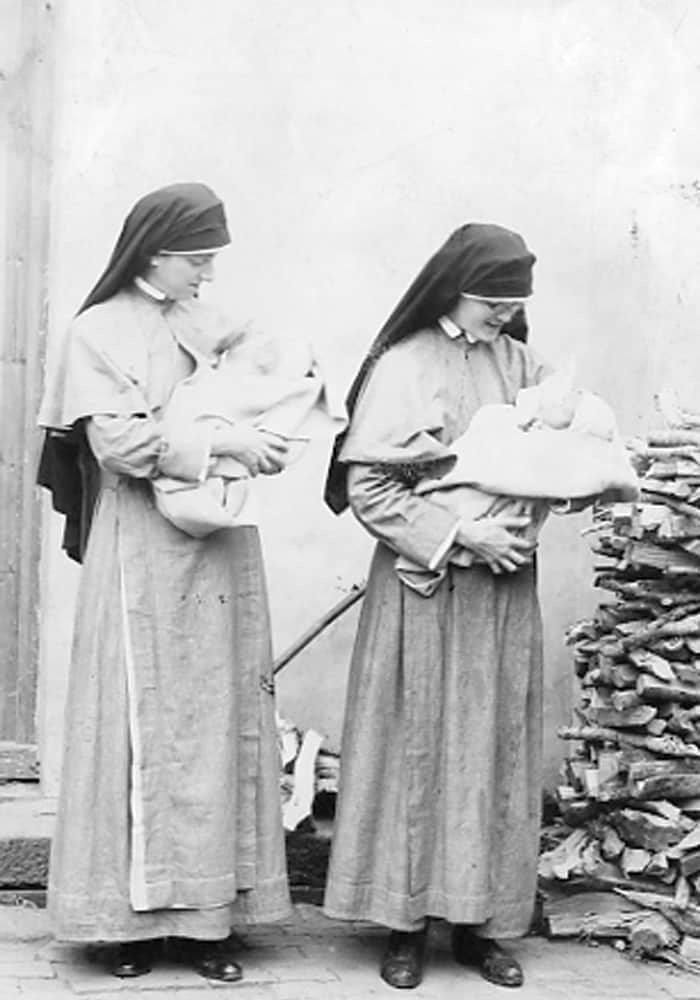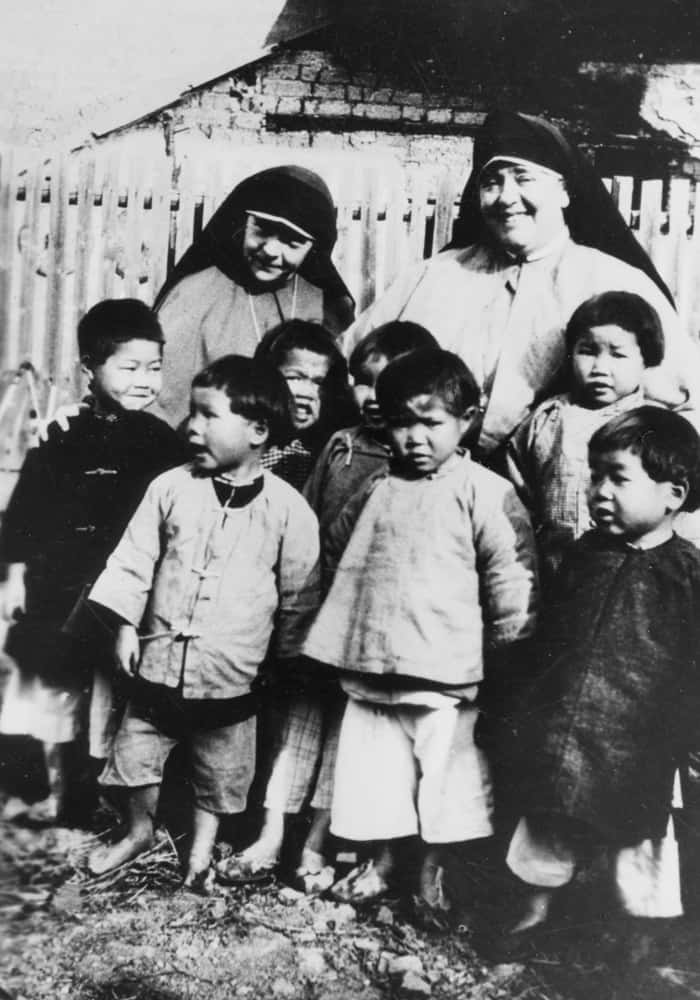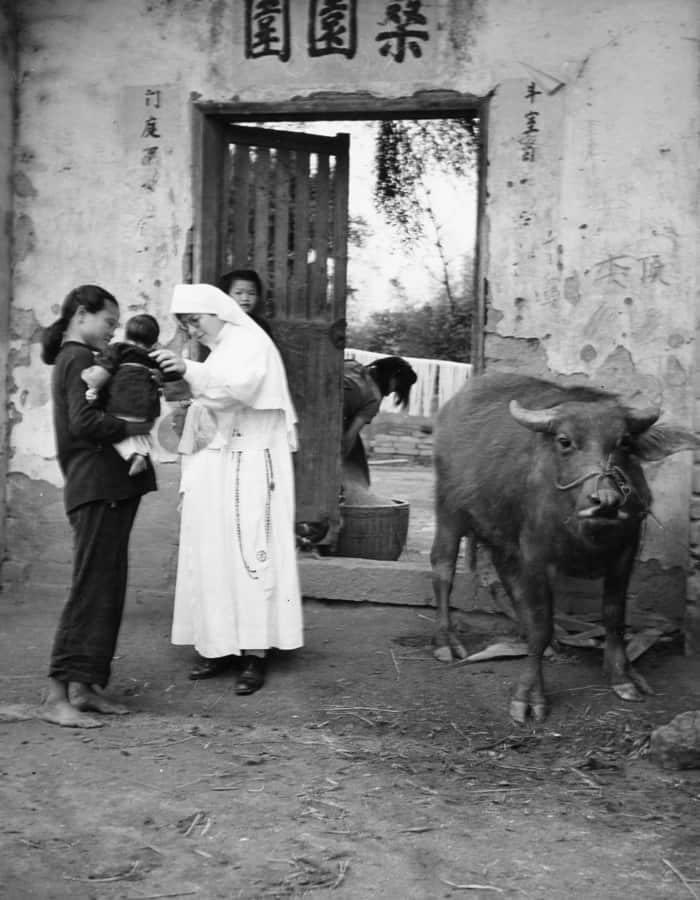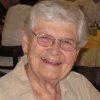The Maryknoll Sisters celebrate 100 years of worldwide mission.
September 12, 1921: the first Maryknoll sisters set out for mission in China. Their departure was both joyful and sobering, as they bid farewell to families and homeland for life. Travel by air was unheard of, so the six women underwent a rough sea journey of 40 days to Kowloon, Hong Kong. They were relieved to see Maryknoll priests and brothers on shore shouting and waving in welcome. Sisters Paul McKenna, Lawrence Foley, Barbara Froehlich, Rose Leifels, Monica Moffatt and Imelda Sheridan had landed. A century of sisters in foreign mission would unfold.
At the beginning of the 20th century, brave young Catholic men and women aspired to travel to China, willing to give their lives to spread the Gospel of Jesus and “to save souls.” The first Maryknoll men who arrived in 1918 had become aware that women missioners were needed to minister to Chinese women. However, many, especially in the Vatican, doubted that American women could withstand the rigors of life in the Orient.
Full of zeal and romantic ideas of being missionaries, the sisters were inexperienced and unprepared for life in China. But, fortified by their deep faith—and the saving grace of a sense of humor—they rolled up their sleeves and went to work.
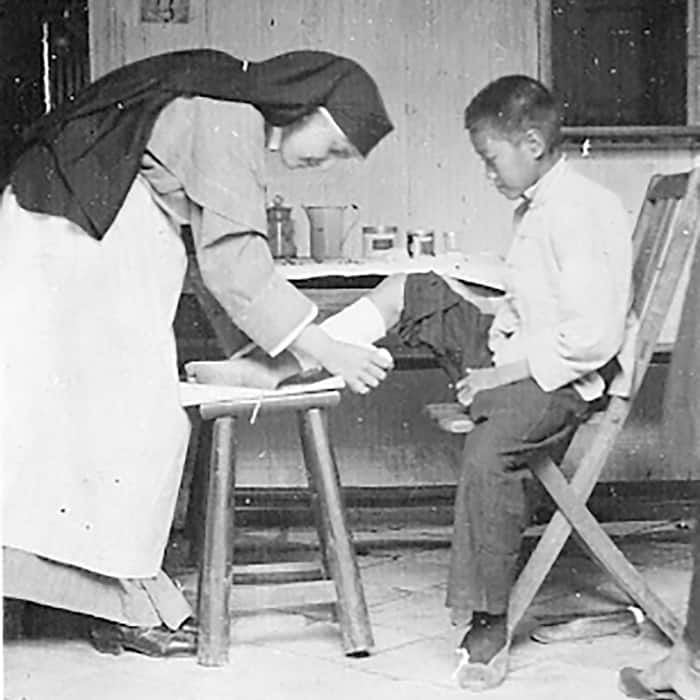
Sister Marie de Lourdes Bourguignon, a registered nurse, treats a young patient in Yeungkong in 1923. (Maryknoll Mission Archives)
The women scrubbed the walls and floors of the old house where they set up residence. Very soon they had a small chapel for the Blessed Sacrament.
In 1922, six more sisters arrived. At the invitation of Maryknoll Father Francis X. Ford, a group of sisters went to Yeungkong, in the south. There Father Ford put them in charge of a school, a house for the elderly and blind girls, an orphanage and a dispensary.
Sister Gertrude Moore, a nurse, ran the dispensary. Within 10 months she treated some 6,000 cases of worms, skin ailments, blood poisoning and eye infections. When a typhoid epidemic broke out, Sister Gertrude attended 50 to 100 patients a day, until contracting the disease herself and dying a few weeks later. This was a terrible blow for the fledgling group.
Mother Mary Joseph Rogers, the Maryknoll Sisters’ mother superior, visited the sisters in China for seven months. She shared their grief over the death of Sister Gertrude and experienced the difficult living conditions endured by her young sisters. For example, the only means of local travel was on filthy “junks,” boats overcrowded with crated livestock and a bucket for sanitary facilities.
During Mother Mary Joseph’s visit, Father Ford observed how easily the Chinese women and children related to her and the sisters. He asked if she would allow pairs of sisters to visit rural women on their homesteads. It was unacceptable for men to do so. The sisters could stay with families, making friends with and learning from them. Mother Mary Joseph heartily approved: wasn’t this the way Jesus sent his disciples out to evangelize, two by two?
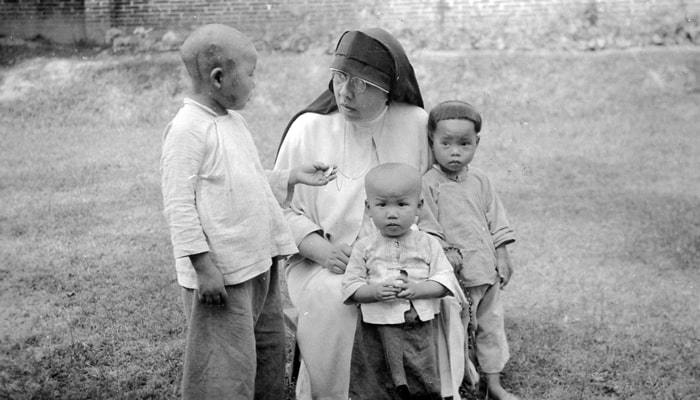
In Loting in 1938, Sister Francis Davis, a member of the second group of sisters sent to China, shares her faith with three girls, one of whom admires her medal. (Maryknoll Mission Archives)
Maryknoll Sister Paulita Hoffmann, assigned to the area of Hakkaland in 1938, recalled, “Father Ford told us very emphatically, ‘Schools and orphanages, the Christians will build later; you are here to bring them the gift of faith and teach the Christian doctrine.’ ”
“The rub was, we had to learn the local dialect of the women, which was different from Cantonese,” Sister Hoffmann explained. Much laughter ensued, she said, as the sisters attempted to repeat words using inflections the village women taught them.
“After carefully copying what we heard in our notebooks, when we would go home, we would give the new words and phrases to two of the sisters who were rewriting them in a book,” Sister Hoffmann continued. “After four or five years, they had a complete course of 18 books!”
This new type of ministry (called “direct evangelization”) was met with criticism by some other religious congregations, who objected to sisters leaving the protection of convent walls. Encouragement arrived in 1939 in a letter to Mother Mary Joseph from Cardinal Pietro Fumasoni-Biondi. He praised their efforts, writing, “Such work and sacrifice … showed courage and devotion.”
By 1941 there were more than 450 Maryknollers in Asia (priests, sisters and brothers). At one time approximately 100 sisters staffed four primary and two secondary schools in Hong Kong.
(Click on the photo below to see slideshow)
Slideshow photos: 1) Sisters Lawrence Foley (l.) and Monica Moffatt hold babies in Yeungkong in 1923. 2) Sister Paul McKenna (l.) and Mother Mary Joseph Rogers with children in China in 1926. 3) Sister Paulita Hoffmann, who died in 2019 after serving as a Maryknoll missioner for 85 years, greets a mother and child in Kaying, China, where she professed her final vows in 1939. (Maryknoll Mission Archives)
A painful turning point came with World War II. Missioners in China were seen as American spies. Many were interned and others deported. Even worse, the subsequent Communist takeover destroyed most missions. Some sisters were interned in prison; others were kept under house arrest and would have starved if kind neighbors had not quietly left them food. In 1951, the Maryknoll Sisters reluctantly left China.
With the door closed to them in mainland China, the sisters crossed back into Hong Kong to reach out to the millions of Chinese fleeing their homeland in search of a new home and freedom. Today, there are only nine Maryknoll sisters in the China Region. But the schools and a hospital continue on, efficiently run by Chinese. Though they were disbanded and persecuted, and their churches destroyed, Chinese Christians hold the seed of faith deeply rooted in their hearts.
In 1962, the Second Vatican Council sought to pastorally adapt the Church and the apostolate to a world undergoing great transformation. It was a new epoch, and a time for revising ideas about mission. Maryknoll sisters’ “direct evangelization” was right in step with this. That understanding of mission evolved into an apostolate of making God’s mercy and love known and experienced through encounters among people and with Jesus Christ on five continents.
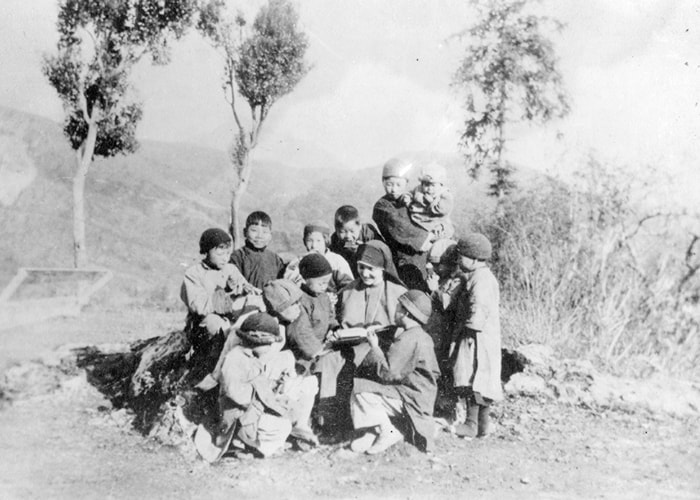
Sister Madeleine Sophie Karlon, who was sent to China in 1934, worked in direct evangelization with women and children in the Kaying Diocese. (Maryknoll Mission Archives)
When asked how all of this had affected her understanding of her missionary vocation, one sister said, “I understand in a deeper way that we are sent to people of other religious beliefs, not to bring God to them, but to help them find a loving God within them.”
Today, Maryknoll Sisters President Antoinette Gutzler says, “As we approach the 100th anniversary of the first six Maryknoll sisters leaving for mission in China, our hearts are filled with gratitude.” She adds that the sisters have chosen September 12th as the beginning date of their next General Assembly. “We will discern the ‘signs of our times,’ embark on new paths in mission, and choose our next Congregational Leadership Team,” Sister Gutzler says.
Understanding of mission has changed; but the call to go forth remains. “We embrace the spirit of our first sisters who left home, family, friends and all they knew to preach the Gospel,” affirms Sister Gutzler. “They gave their lives to ‘make God’s love visible.’ We pledge to do the same.”
Featured image: Maryknoll Society co-founder Father James A. Walsh and (seated, second from left) Mother Mary Joseph Rogers with first departure group: Sisters (standing, left to right) Imelda Sheridan, Barbara Froehlich, Monica Moffatt; (seated, left) Rose Leifels, (seated, second from right) Paul McKenna, (seated, right) Lawrence Foley. (Maryknoll Mission Archives)
FOR INFORMATION ON BECOMING A MARYKNOLL SISTER, Contact Sister Gloria Ardenio Agnes at 914-941-7575, ext. 5612, email: vocation@mksisters.org | maryknollsisters.org
![]()
